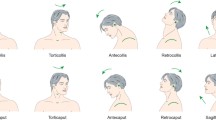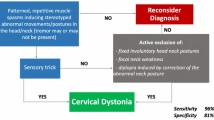Abstract
At first glance, cervical dystonia might be an illustration of the well-known proposition “function follows form”. Nevertheless, cervical dystonia is a highly non-physiological condition, which cannot be reproduced by healthy subjects and does not respond to the usual physiological rules. “Dysfunction follows form” might be the most accurate aphorism to define cervical dystonia. Taking into account this situation and recent insights, the anatomic approach needs to be adapted to allow a better understanding of semiology and to improve botulinum toxin therapy. In this review dealing with a new approach to cervical dystonia, we develop some practical anatomical concepts concerning the head and neck complex. Knowledge of cervical spine and muscular dysfunctions in cervical dystonia is an essential stage in treating cervical dystonia patients with botulinum toxin.






Similar content being viewed by others
References
Bergman RA (2015) Function follows form. Clin Anat 28:956
Buchthal F, Schmalbruch H (1980) Motor unit of mammalian muscle. Physiol Rev 60:90–142
Bull ML, De Freitas V, Vitti M (1984) Electromyographic study of the trapezius (pars superior) and levator scapulae muscles in the movements of the head. Electromyogr Clin Neurophysiol 24:217–223
Delnooz CC, Veugen LC, Pasman JW, Lapatki BG, van Dijk JP, van de Warrenburg BP (2014) The clinical utility of botulinum toxin injections targeted at the motor endplate zone in cervical dystonia. Eur J Neurol 21:1486–1492
Falla D, Dall’Alba P, Rainoldi A, Merletti R, Jull G (2002) Location of innervation zones of sternocleidomastoid and scalene muscles—a basis for clinical and research electromyography applications. Clin Neurophysiol 113:57–63
Hefter H, Blondin D, Kahlen U, Moll M, Antoch G, Schek J (2012) CT-guided intramuscular botulinum toxin A injections into the deep anterior neck muscles in patients with pure antecaput or antecollis. Basal Ganglia 2:97–101
Jinnah HA, Goodmann E, Rosen AR, Evatt M, Freeman A, Factor S (2016) Botulinum toxin treatment failures in cervical dystonia: causes, management, and outcomes. J Neurol 263:1188–1194
Jost WH, Tatu L (2015) Selection of muscles for botulinum toxin injections in cervical dystonia. Mov Disord Clin Pract 2:224–226
Kapandji IA (2008) The physiology of the joints. Trunk and Spine, vol 3. Churchill Livingstone, London
Lee JH, Lee BN, Han SH, An XC, Chung RH (2011) The effective zone of botulinum toxin a injections in the sternocleidomastoid muscle. Surg Radiol Anat 33:185–190
Mayoux Benhamou MA, Revel M, Vallee C (1995) Surface electrodes are not appropriate to record selective myoelectric activity of splenius capitis in humans. Exp Brain Res 105:432–438
Mayoux Benhamou MA, Revel M, Vallee C (1997) Selective electromyography of dorsal neck muscles in humans. Exp Brain Res 113:353–360
Reichel G (2011) Cervical dystonia: a new phenomenological classification for botulinum toxin therapy. Basal Ganglia 1:5–12
Schramm A, Möbius C, Stark D, Huber D, Kohl Z (2014) Involvement of the obliquus capitis inferior muscle in dystonic head tremor. Mov Disord 29(S1):526
Schramm A, Bäumer T, Fietzek U, Heitmann S, Walter U, Jost WH (2015) Relevance of sonography for botulinum toxin treatment of cervical dystonia: an expert statement. J Neural Transm 122:1457–1463
Segal RL, Wolf SL, De Camp MJ, Chopp MT, English AW (1991) Anatomical partitioning of three multiarticular human muscles. Acta Anat 142:261–266
Tabeke K, Vitti M, Basmajian JV (1974) The functions of semispinalis capitis and splenius capitis muscles: an electromyographic study. Anat Record 179:477–480
Tatu L, Parratte B (2016) Functional anatomy of the muscle. In: Roger B, Hamilton B, Skaf A (eds) Acute and chronic muscular pathology in the athlete. Springer, Heidelberg (in press)
Tubbs RS (2015) Form follows function or does it? Clin Anat 28:955
Windhorst U, Hamm TM, Stuart DG (1989) On the function of muscle and reflex partitioning. Behav Brain Sci 12:629–681
Wissel J, Kanovsky P, Ruzicka E, Bares M, Hortova H, Streitova H, Jech R, Roth J, Brenneis C, Müller J, Schnider P, Auff E, Richardson A, Poewe W (2001) Efficacy and safety of a standardised 500 unit dose of Dysport (clostridium botulinum toxin type a haemaglutinin complex) in a heterogeneous cervical dystonia population: results of a prospective, multicentre, randomised, double-blind, placebo-controlled, parallel group study. J Neurol 248:1073–1078
Author information
Authors and Affiliations
Corresponding author
Rights and permissions
About this article
Cite this article
Tatu, L., Jost, W.H. Anatomy and cervical dystonia. J Neural Transm 124, 237–243 (2017). https://doi.org/10.1007/s00702-016-1621-7
Received:
Accepted:
Published:
Issue Date:
DOI: https://doi.org/10.1007/s00702-016-1621-7




